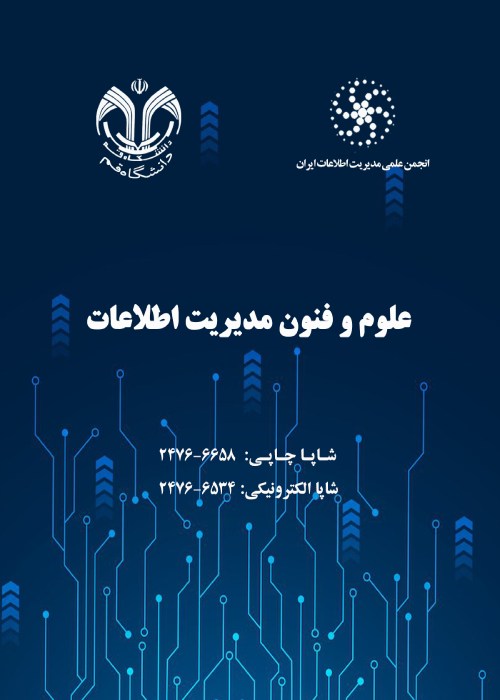Investigating the Status of knowledge management in scientometrics units of medical universities in Iran
Author(s):
Article Type:
Research/Original Article (دارای رتبه معتبر)
Abstract:
Purpose
The aim of this study is to validate the proposed model of knowledge management and investigate the status of knowledge management in scientometrics units of medical universities in Iran. Understanding how knowledge is created and managed, identifying the components of knowledge management within these units, determining a suitable knowledge management model for medical universities, and assessing the role of scientometrics units in knowledge management are essential.Method
The present study is practical in terms of purpose and was conducted using a descriptive survey. The data gathering tool was a researcher-made questionnaire based on the proposed model in the study. It included 5 knowledge management components: identification components (18 items), acquisition (11 items), application (9 items), registration (6 items), and presentation (8 items), set up in the Likert spectrum. The study community consisted of all managers and staff affiliated with the University of Medical Sciences in Iran. 164 people were identified by reviewing the websites of active scientometrics units at the medical universities in Iran. According to Morgan's table, the number of samples required was determined to be 115 by a random selection process. 84 completed questionnaires were received. Data from 84 questionnaires were analyzed, as the return rate exceeded 70%. The content validity method has been utilized to assess the validity of the questionnaire. In the present study, the questionnaire was formulated and validated based on the input of seven experts, including four faculty members and three specialists who are also authors of relevant articles. The validity of the study was also examined through confirmatory factor analysis. The reliability of this study was assessed using the internal consistency (Cronbach's alpha) method with the assistance of SPS software. The obtained reliability coefficient for the entire questionnaire was 0.949. Information analysis was conducted using structural equations and PLS software to assess model validity. Additionally, sample and bipolarized TT exams were employed to investigate the status of knowledge management components.Findings
The proposed model of knowledge management was formulated in medical universities, encompassing five components: identification (12 items), acquisition (10 items), application (eight items), registration (five items), and presentation (seven items). The measurement model test includes a reliability test (observable variables, composite reliability, and Cronbach's alpha), a narrative test (involving convergence validity and divergent validity), and a validity test for quality, which was approved. For the knowledge management variable and the two components of identifying and acquiring knowledge, the significance level of the Kolmogorov-Smirnov test was greater than 0.5. Therefore, data skewness is not significant, and the data is considered to be normally distributed. Therefore, the T-test is used to examine their status. The data is not normal for the components of application, registration, and presentation of knowledge, and a two-sample test is used. The results of the single-variable t-test and the two-sample t-test showed that the knowledge management variable and the components of knowledge identification, knowledge acquisition, and knowledge application are statistically above average (score of 3). However, for the two components of registering and presenting knowledge, the results were not statistically significant and were average (score of 3). Given that knowledge management in Iranian organizations is not very well-established, most research has reported that the status of knowledge management and its components in Iranian organizations is at a moderate and inadequate level. However, the conclusion of this study indicates that the status of knowledge management components, including identifying knowledge, acquiring knowledge, and applying knowledge in the field of scientometrics, is moderately high. However, in the components of registration and presentation, the status was lower.Conclusion
The proposed model of knowledge management in medical universities comprises five components: identification, acquisition, registration, application, and dissemination of knowledge. This model can serve as a reference and framework for implementation in other universities.Keywords:
Language:
Persian
Published:
Journal of Sciences and Techniques of Information Management, Volume:9 Issue: 4, 2023
Pages:
359 to 384
magiran.com/p2708972
دانلود و مطالعه متن این مقاله با یکی از روشهای زیر امکان پذیر است:
اشتراک شخصی
با عضویت و پرداخت آنلاین حق اشتراک یکساله به مبلغ 1,390,000ريال میتوانید 70 عنوان مطلب دانلود کنید!
اشتراک سازمانی
به کتابخانه دانشگاه یا محل کار خود پیشنهاد کنید تا اشتراک سازمانی این پایگاه را برای دسترسی نامحدود همه کاربران به متن مطالب تهیه نمایند!
توجه!
- حق عضویت دریافتی صرف حمایت از نشریات عضو و نگهداری، تکمیل و توسعه مگیران میشود.
- پرداخت حق اشتراک و دانلود مقالات اجازه بازنشر آن در سایر رسانههای چاپی و دیجیتال را به کاربر نمیدهد.
In order to view content subscription is required
Personal subscription
Subscribe magiran.com for 70 € euros via PayPal and download 70 articles during a year.
Organization subscription
Please contact us to subscribe your university or library for unlimited access!




